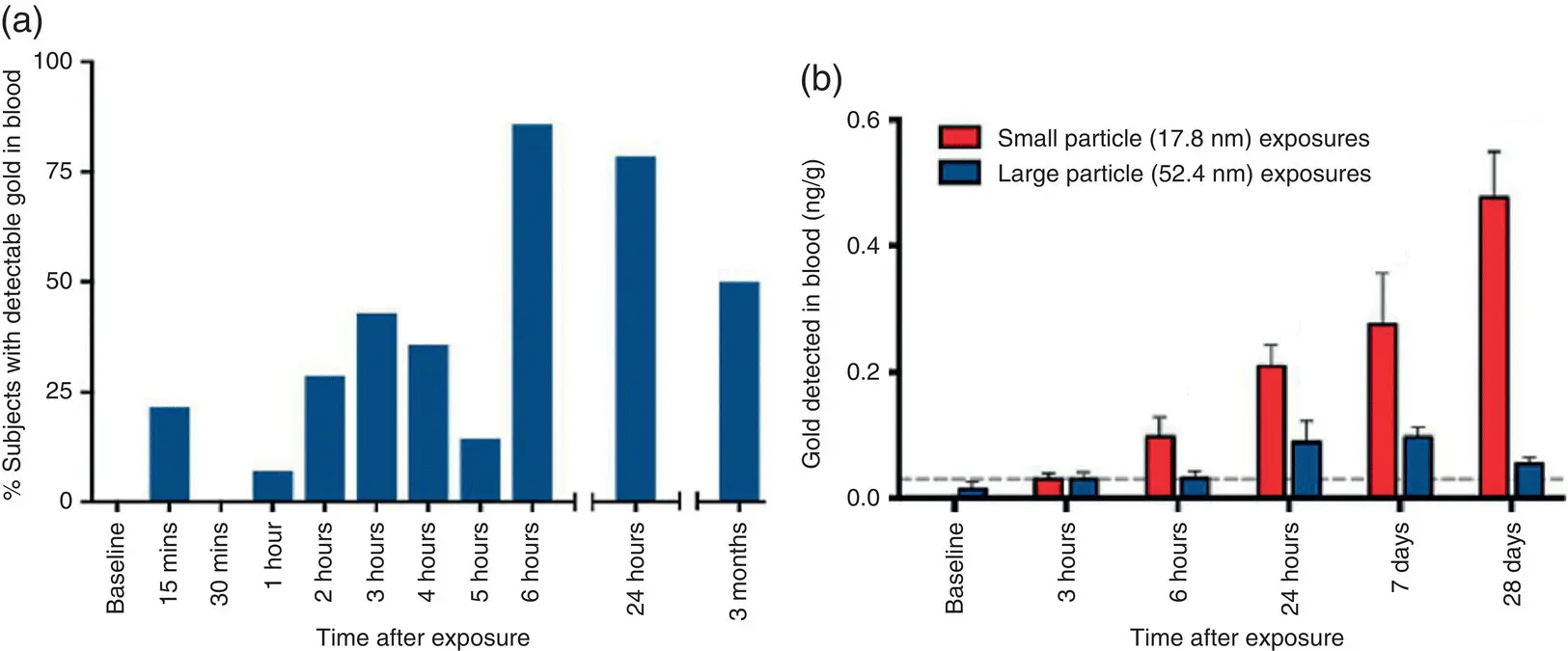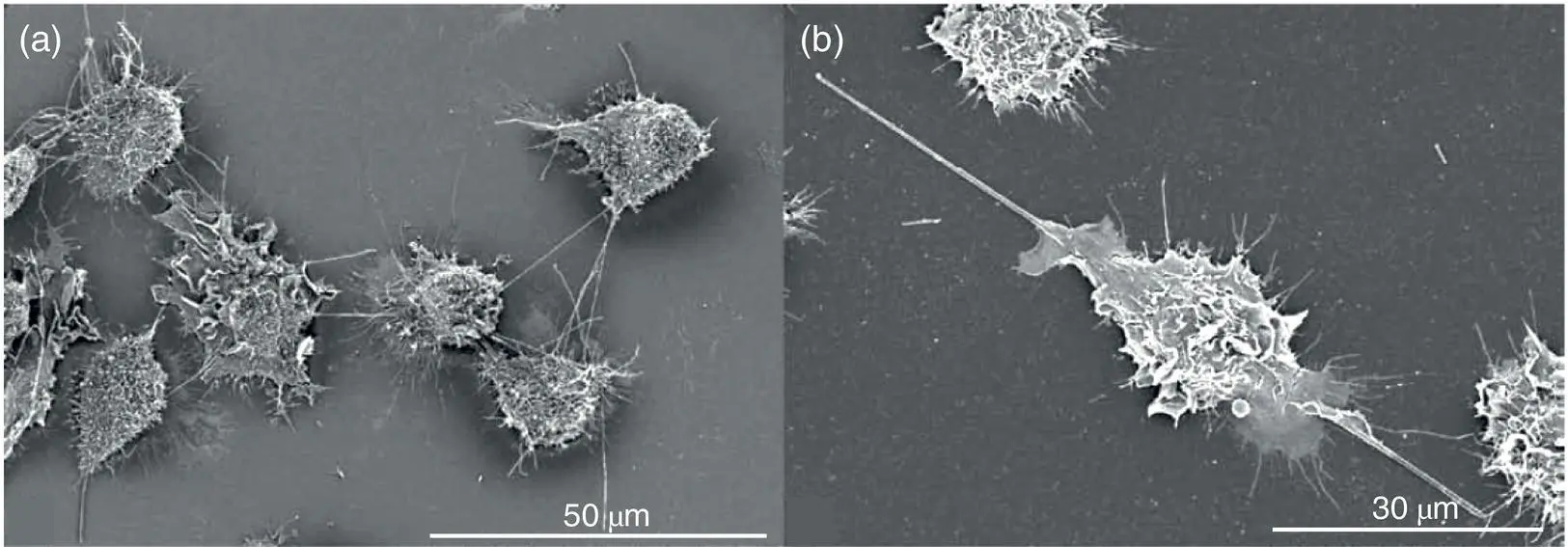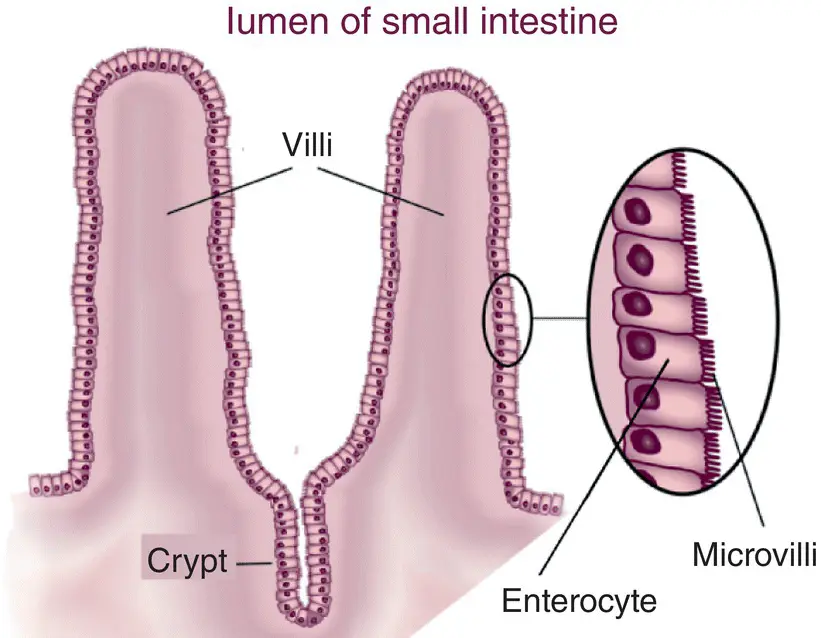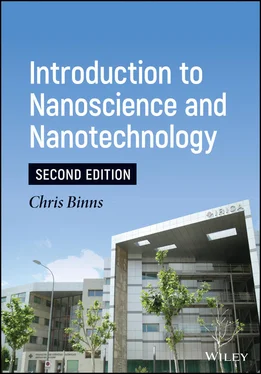The same study also examined the effect of particle size on translocation with the results shown in Figure 2.5b. It is evident that a much lower fraction of larger particles is able to enter the bloodstream as would be expected. Not all the particles were passed out into the urine or feces and animal studies showed the accumulation of Au nanoparticles in tissues especially at sites of lesions, which could be a mechanism for triggering cardiovascular disease.

Figure 2.5 Translocation of Au nanoparticles from the lungs into blood circulation.(a) Percentage of 14 volunteers with detectable Au in the blood as a function of time after breathing in a Au aerosol of 18.7 nm diameter Au nanoparticles. (b) Effect of nanoparticle size on translocation as a function of time in 10 volunteers (small particles) and nine volunteers (large particles).
Source : Reproduced with the permission of the American Chemical Society from M. R. Miller et al. [9].

Figure 2.6 Frustrated phagocytosis.Scanning electron microscopy image of macrophages undergoing frustrated phagocytosis induced by (a) multiwalled carbon nanotubes and (b) an asbestos fiber.
Source : Reproduced from [10].
Fibrous nanomaterials in the form of carbon nanotubes (see Chapter 3) introduce an additional hazard that has been known for some time in the case of glass and asbestos fibers. Since the macrophages have a typical size of 10–15 μm, fibers longer than this lead to a phenomenon known as frustrated phagocytosis when the macrophage attempts to ingest the fiber. The foreign object is not fully encased leading to a release of digestive enzymes, toxic oxygen, and nitrogen, which can damage nearby healthy cells. Figure 2.6b shows an electron microscope image of frustrated phagocytosis after a macrophage has tried to ingest an asbestos fiber and Figure 2.6a shows a group of macrophages undergoing frustrated phagocytosis of carbon nanotubes.
2.2.2 Entry Via the Intestines
The lung clearance mechanism is designed to get the nanoparticles out of the lung and into the digestive system via the saliva and removed from the body by the reticuloendothelial system (RES) described in Chapter 8, Section 8.1.2. The system removes the vast majority of nanoparticles via the urine and feces but some swallowed particles can get in (or, in the case of nanoparticles cleared from the lungs, back in) via the small intestine. This is designed to remove useful molecular ingredients, like fats, carbohydrates, etc. from the food that has been broken down in the stomach and enter them into the blood circulation where they can be used by the body's cells. The fluid containing the processed food is carried through the central tube of the intestine (the lumen), whose walls are made of small finger‐like projections called villi, shown in Figure 2.7. The villi are constructed from tightly packed cells knows as enterocytes that are special designed to ingest matter and themselves have contorted membranes with tiny projections called microvilli. This highly convoluted interior presents a surface area in the region of 200 m 2, that is, even more than the lungs. The villi are permeated with tiny blood vessels so that useful molecules, which are further processed by the enterocytes, are able to pass into the bloodstream and this is also the route by which nanoparticles can enter.
The uptake of nanoparticles in the intestinal tract is complicated and there are other routes into the circulation as well as through the enterocytes. It has been shown that translocation depends on particle size, coating and surface charge [6]. The first barrier to cross is a mucous layer, which is excreted by specialist cells known as goblet cells that are interspersed with the enterocytes in the villi walls and is designed to act as a filter. It was shown more than 20 years ago that 14 nm latex particles could cross this barrier in 2 minutes while it took 415 nm particles 30 minutes and 1000 nm particles were unable to cross at all [11]. The enterocytes act as a further barrier and again, the ability to be absorbed and pass into the interior of the villi depends on a number of factors including size. As well as blood vessels, the villi are permeated with lymph vessels and nanoparticles that make it through the wall can enter the lymph system, where they are likely to trigger an immune response or the blood circulation where the ones that are not removed (<10%) can be deposited in different organs.

Figure 2.7 Villi and microvilli of the small intestine.The surface of the central tube (lumen) of the small intestine is made of finger‐like projections (villi), which are composed of enterocytes that themselves have hairlike projections (microvilli). The internal surface presents an area of some 200 m 2to the passing fluid containing nutrients.
Source : BallenaBlanca. https://commons.wikimedia.org/wiki/File:Villi_%26_microvilli_of_small_intestine.svg. Licensed under CC BY‐SA 4.0 ( https://creativecommons.org/licenses/by‐sa/4.0/deed.en).
2.2.3 Nanoparticles and the Skin
Human skin, with a typical surface area of 1.5 m 2, is an impenetrable barrier to the environment preventing the entry of any foreign matter. The structure, shown in Figure 2.8, is divided into three layers called the epidermis, the dermis and the subcutaneous layer with the surface layer of the epidermis composed of a layer of dead cells about 10 μm thick known as the stratum corneum. The dermis is a layer of living cells permeated with blood vessels near its base containing the oil and sweat glands and the hair follicles. The epidermis is also composed of living cells apart from the stratum corneum and contains the specialist melanin producing cells (melanocytes) that determine skin color.
Zinc oxide (ZnO) and titanium dioxide (TiO 2) nanoparticles in the size range 20–30 nm are widely used in cosmetic products such as sunscreens and there has been some concern that penetration to the bottom of the dermis could allow such particles to enter the blood circulation. To date, however there is no evidence that this can occur, indeed, studies of 18 nm ZnO nanoparticles [12] show that they do not penetrate the stratum corneum. Although particles can enter the hair follicles at the hair root, this part of the channel is also covered with a dead layer and prevents the particles reaching live layers. There has been some interest in transdermal applications of drugs, which is possible using microemulsions [13] though this is not relevant to nanoparticles.

Figure 2.8 Structure of skin. Human skin consists of three basic layers labeled the epidermis the dermis and the subcutaneous layer.The dermis is composed of living cells and contains, hair follicles, oil, and sweat glands. The epidermis is also composed of living cells apart from the top 10 μm, which is a layer of dead cells known as the stratum corneum.
2.2.4 Air Quality Specifications
Читать дальше
















